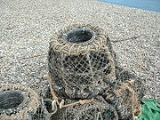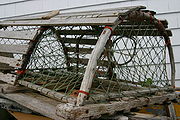
Lobster trap
Encyclopedia
Not to be confused with Lobster-tailed pot
A lobster trap or lobster pot is a portable trap that traps lobsters or crayfish
and is used in lobster fishing
. A lobster trap can hold several lobsters. Lobster traps are constructed of wire and wood. An opening permits the lobster to enter a tunnel of netting. Pots are usually constructed in two parts, called the "chamber" or “kitchen”, where there is bait, and exits into the “parlour”, where it is trapped from escape. Lobster pots are usually dropped to the sea floor about a dozen at a time, and are marked by a buoy
so they can be picked up later.
 The trap can consist of a wood
The trap can consist of a wood
en frame surrounded by a rope
mesh. The majority of the newer traps found in the Northeast of the USA and the Canadian Maritimes
consist of a plastic-coated metal frame. A piece of bait
, often fish
or chum
, is placed inside the trap, and the traps are dropped onto the sea floor. A long rope is attached to each trap, at the end of which is a plastic or styrofoam
buoy
that bears the owner's license number. The entrances to the traps are designed to be one-way entrances only. The traps are checked every other day by the fisherman and rebaited if necessary. One study indicated that lobster traps are very inefficient and allow almost all lobsters to escape.
. By 1810, the wooden lath trap is said to have originated in Cape Cod
, Massachusetts. New England
fishermen in the United States used it for years before American companies introduced it to the Canadian fishery through their Atlantic coast canneries.
An 1899 report by the United States Fish Commission
on the Lobster Fishery Of Maine, described the local "lath pots" used by Maine
lobster fishers:
A lobster trap or lobster pot is a portable trap that traps lobsters or crayfish
Crayfish
Crayfish, crawfish, or crawdads – members of the superfamilies Astacoidea and Parastacoidea – are freshwater crustaceans resembling small lobsters, to which they are related...
and is used in lobster fishing
Lobster fishing
Lobster fishing, sometimes called lobstering, is the commercial or recreational harvesting of marine lobsters, spiny lobsters or crayfish.-Lobster tools and technology:...
. A lobster trap can hold several lobsters. Lobster traps are constructed of wire and wood. An opening permits the lobster to enter a tunnel of netting. Pots are usually constructed in two parts, called the "chamber" or “kitchen”, where there is bait, and exits into the “parlour”, where it is trapped from escape. Lobster pots are usually dropped to the sea floor about a dozen at a time, and are marked by a buoy
Buoy
A buoy is a floating device that can have many different purposes. It can be anchored or allowed to drift. The word, of Old French or Middle Dutch origin, is now most commonly in UK English, although some orthoepists have traditionally prescribed the pronunciation...
so they can be picked up later.
Description

Wood
Wood is a hard, fibrous tissue found in many trees. It has been used for hundreds of thousands of years for both fuel and as a construction material. It is an organic material, a natural composite of cellulose fibers embedded in a matrix of lignin which resists compression...
en frame surrounded by a rope
Rope
A rope is a length of fibres, twisted or braided together to improve strength for pulling and connecting. It has tensile strength but is too flexible to provide compressive strength...
mesh. The majority of the newer traps found in the Northeast of the USA and the Canadian Maritimes
Maritimes
The Maritime provinces, also called the Maritimes or the Canadian Maritimes, is a region of Eastern Canada consisting of three provinces, New Brunswick, Nova Scotia, and Prince Edward Island. On the Atlantic coast, the Maritimes are a subregion of Atlantic Canada, which also includes the...
consist of a plastic-coated metal frame. A piece of bait
Bait (luring substance)
Bait is any substance used to attract prey, e.g. in a mousetrap.-In Australia:Baiting in Australia refers to specific campaigns to control foxes, wild dogs and dingos by poisoning in areas where they are a problem...
, often fish
Fish
Fish are a paraphyletic group of organisms that consist of all gill-bearing aquatic vertebrate animals that lack limbs with digits. Included in this definition are the living hagfish, lampreys, and cartilaginous and bony fish, as well as various extinct related groups...
or chum
Chumming
Chumming is the practice of luring animals, usually fish or sharks, by throwing "chum" into the water. Chum often consists of fish parts and blood, which attract fish, particularly sharks due to their keen sense of smell....
, is placed inside the trap, and the traps are dropped onto the sea floor. A long rope is attached to each trap, at the end of which is a plastic or styrofoam
Styrofoam
Styrofoam is a trademark of The Dow Chemical Company for closed-cell currently made for thermal insulation and craft applications. In 1941, researchers in Dow's Chemical Physics Lab found a way to make foamed polystyrene...
buoy
Buoy
A buoy is a floating device that can have many different purposes. It can be anchored or allowed to drift. The word, of Old French or Middle Dutch origin, is now most commonly in UK English, although some orthoepists have traditionally prescribed the pronunciation...
that bears the owner's license number. The entrances to the traps are designed to be one-way entrances only. The traps are checked every other day by the fisherman and rebaited if necessary. One study indicated that lobster traps are very inefficient and allow almost all lobsters to escape.
History
The lobster trap was invented in 1808 by Ebenezer Thorndike of Swampscott, MassachusettsSwampscott, Massachusetts
Swampscott is a town in Essex County, Massachusetts, United States located 15 miles up the coast from Boston in an area known as the North Shore. The population is 13,787...
. By 1810, the wooden lath trap is said to have originated in Cape Cod
Cape Cod
Cape Cod, often referred to locally as simply the Cape, is a cape in the easternmost portion of the state of Massachusetts, in the Northeastern United States...
, Massachusetts. New England
New England
New England is a region in the northeastern corner of the United States consisting of the six states of Maine, New Hampshire, Vermont, Massachusetts, Rhode Island, and Connecticut...
fishermen in the United States used it for years before American companies introduced it to the Canadian fishery through their Atlantic coast canneries.
An 1899 report by the United States Fish Commission
United States Fish Commission
The United States Commission of Fish and Fisheries was established on February 9, 1871 , as an independent commission with a mandate to investigate the causes for the decrease of commercial fish and aquatic animals in U.S...
on the Lobster Fishery Of Maine, described the local "lath pots" used by Maine
Maine
Maine is a state in the New England region of the northeastern United States, bordered by the Atlantic Ocean to the east and south, New Hampshire to the west, and the Canadian provinces of Quebec to the northwest and New Brunswick to the northeast. Maine is both the northernmost and easternmost...
lobster fishers:

